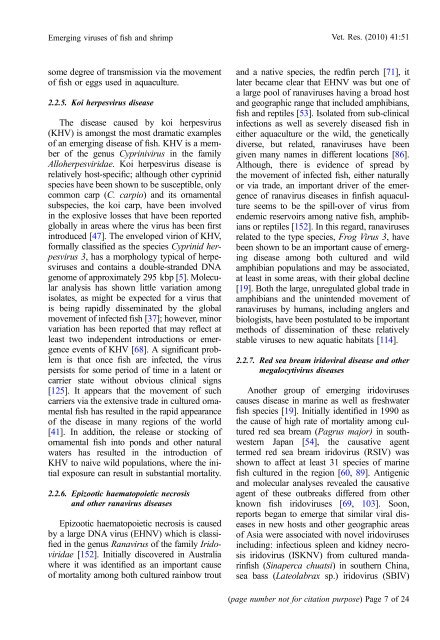Emerging viral diseases of fish and shrimp - Watershed Watch ...
Emerging viral diseases of fish and shrimp - Watershed Watch ...
Emerging viral diseases of fish and shrimp - Watershed Watch ...
You also want an ePaper? Increase the reach of your titles
YUMPU automatically turns print PDFs into web optimized ePapers that Google loves.
<strong>Emerging</strong> viruses <strong>of</strong> <strong>fish</strong> <strong>and</strong> <strong>shrimp</strong> Vet. Res. (2010) 41:51<br />
some degree <strong>of</strong> transmission via the movement<br />
<strong>of</strong> <strong>fish</strong> or eggs used in aquaculture.<br />
2.2.5. Koi herpesvirus disease<br />
The disease caused by koi herpesvirus<br />
(KHV) is amongst the most dramatic examples<br />
<strong>of</strong> an emerging disease <strong>of</strong> <strong>fish</strong>. KHV is a member<br />
<strong>of</strong> the genus Cyprinivirus in the family<br />
Alloherpesviridae. Koi herpesvirus disease is<br />
relatively host-specific; although other cyprinid<br />
species have been shown to be susceptible, only<br />
common carp (C. carpio) <strong>and</strong> its ornamental<br />
subspecies, the koi carp, have been involved<br />
in the explosive losses that have been reported<br />
globally in areas where the virus has been first<br />
introduced [47]. The enveloped virion <strong>of</strong> KHV,<br />
formally classified as the species Cyprinid herpesvirus<br />
3, has a morphology typical <strong>of</strong> herpesviruses<br />
<strong>and</strong> contains a double-str<strong>and</strong>ed DNA<br />
genome <strong>of</strong> approximately 295 kbp [5]. Molecular<br />
analysis has shown little variation among<br />
isolates, as might be expected for a virus that<br />
is being rapidly disseminated by the global<br />
movement <strong>of</strong> infected <strong>fish</strong> [37]; however, minor<br />
variation has been reported that may reflect at<br />
least two independent introductions or emergence<br />
events <strong>of</strong> KHV [68]. A significant problem<br />
is that once <strong>fish</strong> are infected, the virus<br />
persists for some period <strong>of</strong> time in a latent or<br />
carrier state without obvious clinical signs<br />
[125]. It appears that the movement <strong>of</strong> such<br />
carriers via the extensive trade in cultured ornamental<br />
<strong>fish</strong> has resulted in the rapid appearance<br />
<strong>of</strong> the disease in many regions <strong>of</strong> the world<br />
[41]. In addition, the release or stocking <strong>of</strong><br />
ornamental <strong>fish</strong> into ponds <strong>and</strong> other natural<br />
waters has resulted in the introduction <strong>of</strong><br />
KHV to naive wild populations, where the initial<br />
exposure can result in substantial mortality.<br />
2.2.6. Epizootic haematopoietic necrosis<br />
<strong>and</strong> other ranavirus <strong>diseases</strong><br />
Epizootic haematopoietic necrosis is caused<br />
by a large DNA virus (EHNV) which is classified<br />
in the genus Ranavirus <strong>of</strong> the family Iridoviridae<br />
[152]. Initially discovered in Australia<br />
where it was identified as an important cause<br />
<strong>of</strong> mortality among both cultured rainbow trout<br />
<strong>and</strong> a native species, the redfin perch [71], it<br />
later became clear that EHNV was but one <strong>of</strong><br />
a large pool <strong>of</strong> ranaviruses having a broad host<br />
<strong>and</strong> geographic range that included amphibians,<br />
<strong>fish</strong> <strong>and</strong> reptiles [53]. Isolated from sub-clinical<br />
infections as well as severely diseased <strong>fish</strong> in<br />
either aquaculture or the wild, the genetically<br />
diverse, but related, ranaviruses have been<br />
given many names in different locations [86].<br />
Although, there is evidence <strong>of</strong> spread by<br />
the movement <strong>of</strong> infected <strong>fish</strong>, either naturally<br />
or via trade, an important driver <strong>of</strong> the emergence<br />
<strong>of</strong> ranavirus <strong>diseases</strong> in fin<strong>fish</strong> aquaculture<br />
seems to be the spill-over <strong>of</strong> virus from<br />
endemic reservoirs among native <strong>fish</strong>, amphibians<br />
or reptiles [152]. In this regard, ranaviruses<br />
related to the type species, Frog Virus 3, have<br />
been shown to be an important cause <strong>of</strong> emerging<br />
disease among both cultured <strong>and</strong> wild<br />
amphibian populations <strong>and</strong> may be associated,<br />
at least in some areas, with their global decline<br />
[19]. Both the large, unregulated global trade in<br />
amphibians <strong>and</strong> the unintended movement <strong>of</strong><br />
ranaviruses by humans, including anglers <strong>and</strong><br />
biologists, have been postulated to be important<br />
methods <strong>of</strong> dissemination <strong>of</strong> these relatively<br />
stable viruses to new aquatic habitats [114].<br />
2.2.7. Red sea bream irido<strong>viral</strong> disease <strong>and</strong> other<br />
megalocytivirus <strong>diseases</strong><br />
Another group <strong>of</strong> emerging iridoviruses<br />
causes disease in marine as well as freshwater<br />
<strong>fish</strong> species [19]. Initially identified in 1990 as<br />
the cause <strong>of</strong> high rate <strong>of</strong> mortality among cultured<br />
red sea bream (Pagrus major) in southwestern<br />
Japan [54], the causative agent<br />
termed red sea bream iridovirus (RSIV) was<br />
shown to affect at least 31 species <strong>of</strong> marine<br />
<strong>fish</strong> cultured in the region [60, 89]. Antigenic<br />
<strong>and</strong> molecular analyses revealed the causative<br />
agent <strong>of</strong> these outbreaks differed from other<br />
known <strong>fish</strong> iridoviruses [69, 103]. Soon,<br />
reports began to emerge that similar <strong>viral</strong> <strong>diseases</strong><br />
in new hosts <strong>and</strong> other geographic areas<br />
<strong>of</strong> Asia were associated with novel iridoviruses<br />
including: infectious spleen <strong>and</strong> kidney necrosis<br />
iridovirus (ISKNV) from cultured m<strong>and</strong>arin<strong>fish</strong><br />
(Sinaperca chuatsi) in southern China,<br />
sea bass (Lateolabrax sp.) iridovirus (SBIV)<br />
(page number not for citation purpose) Page 7 <strong>of</strong> 24
















